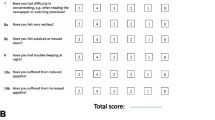Summary
Depressive symptoms are extremely common in the general population and, particularly, in the medically ill. The diagnostic criteria for a major depressive disorder set a clinical threshold for the forms of depression requiring specific treatment. However, the criteria require a specialised psychiatric interview and are difficult to use outside of psychiatry. For screening purposes, self-rating questionnaires have been proposed, but none have appeared to be completely satisfactory. There is much evidence that depression in the medically ill is frequently unrecognised and untreated.
The diagnostic criteria for major depression are the essential tools for case identification and inclusion in studies (particularly if involving experiments in therapeutics, such as drug trials). However, they do not provide an adequate threshold for intensity of symptoms and, in some cases, should be supplemented by other instruments.
It is only in recent years that it has become apparent that, despite effective treatments, the longer term outcome in depression is still problematic. Current treatment protocols appear to be largely inadequate in relapse prevention. Screening for depressive relapse and subclinical symptomatology that entails considerable prognostic value thus becomes of considerable value. Such screening requires a conceptual shift from current oversimplified views on assessment and course of depressive episodes based on psychometric principles to multimodal, clinically derived approaches according to clinimetric principles. Depression appears to be more and more a potentially chronic and greatly invalidating disease that represents a major challenge to modern healthcare.
Similar content being viewed by others
References
Feighner JP, Robins E, Guze SB, et al. Diagnostic criteria for use in psychiatric research. Arch Gen Psychiatry 1972; 26: 57–63
Spitzer RL, Endicott J, Robins E. Research diagnostic criteria: rationale and reliability. Arch Gen Psychiatry 1978; 35: 773–82
American Psychiatric Association. Diagnostic and Statistical Manual of Mental Disorders (DSM-III). 3rd ed. Washington: APA, 1980
American Psychiatric Association. Diagnostic and Statistical Manual for Mental Disorders (DSM-IV). 4th ed. Washington: APA, 1994
Paykel ES, Hollyman JA, Freeling P, et al. Predictors of therapeutic benefit from amitriptyline in mild depression. J Affect Disord 1988; 14: 83–95
Angst J, Kupfer DJ, Rosenbaum JF. Recovery from depression: risk or reality? Acta Psychiatr Scand 1996; 93: 413–
Wells KB, Stewart A, Hays RD, et al. The functioning and well-being of depressed patients. JAMA 1989; 262: 914–9
Fava GA, Sonino N. Depression associated with medical illness: treatment considerations. CNS Drugs 1996; 5: 175–89
Feinberg M, Carroll BJ, Steiner M, et al. Misdiagnoses of endogenous depression with research diagnostic criteria [letter]. Lancet 1979; I: 267
Thornicroft G, Tansella M, editors. Mental health outcome measures. Berlin: Springer, 1996
Hamilton M. A rating scale for depression. J Neurol Neurosurg Psychiatry 1960; 23: 56–62
Fava GA, Kellner R, Munari F, et al. The Hamilton Depression Rating Scale in normals and depressives. Acta Psychiatr Scand 1982; 66: 26–32
Kellner R, Sheffield BF. A self-rating scale of distress. Psychol Med 1973; 3: 88–100
Paykel ES. Relapse, recurrence and chronicity in depression. In: Langer SZ, Brunello N, Racagni G, et al., editors. Critical issues in the treatment of affective disorders. Basel: Karger, 1994: 9–20
Fava GA. The concept of recovery in affective disorders. Psychother Psychosom 1996; 65: 2–13
Wells KB, Burnam MA, Rogers W, et al. The course of depression in adult outpatients. Arch Gen Psychiatry 1992; 49: 788–94
Rogers WH, Wells KB, Meredith LS, et al. Outcomes for adult outpatients with depression under prepaid or fee-for-service financing. Arch Gen Psychiatry 1993; 50: 517–27
Depression Guideline Panel. Depression in primary care. Rockville (MD): Agency for Health Care Policy and Research, 1993
Fava GA, Kellner R. Staging. Acta Psychiatr Scand 1993; 87: 225–30
Wright JG, Feinstein AR. A comparative contrast of clinimetric and psychometric methods for constructing indexes and rating scales. J Clin Epidemiol 1992; 45: 1201–18
Feinstein AR. Clinimetrics. New Haven: Yale University Press, 1987
Ryff CD, Singer B. Psychological well-being. Psychother Psychosom 1996; 65: 14–23
Fava GA. Methodological and conceptual issues in research on quality of life. Psychother Psychosom 1990; 54: 70–6
American Psychiatric Association. Practice guideline for major depressive disorder in adults. Am J Psychiatry 1993; 150 Suppl.: 1–26
Fava GA, Grandi S, Zielezny M, et al. Cognitive behavioral treatment of residual symptoms in primary major depressive disorder. Am J Psychiatry 1994; 151: 1295–9
Fava GA, Grandi S, Zielezny M, et al. Four year outcome for cognitive behavioral treatment of residual symptoms in major depression. Am J Psychiatry 1996; 153: 945–7
Fava GA. Do antidepressant and antianxiety drugs increase chronicity in affective disorders? Psychother Psychosom 1994; 61: 125–
Baldessarini RJ. Risks and implications of interrupting maintenance psychotropic drug therapy. Psychother Psychosom 1995; 63: 137–41
Fava GA. Holding on: depression, sensitization by antidepressant drugs, and the prodigal experts. Psychother Psychosom 1995; 64: 57–61
Stoudemire A, Frank R, Hademark N, et al. The economic burden of depression. Gen Hosp Psychiatry 1986; 8: 387–94
Kind P, Soresen J. The costs of depression. Int Clin Psychopharmacol 1993; 7: 191–5
Mintz J, Mintz LI, Arruda MJ, et al. Treatments of depression and the functional capacity to work. Arch Gen Psychiatry 1992; 49: 761–8
Author information
Authors and Affiliations
Additional information
About the Author: Dr Fava is Associate Professor of Psychosomatic Medicine at the University of Bologna, and Clinical Professor of Psychiatry, State University of New York at Buffalo. His research interests include mood and anxiety disorders and psychsomatic medicine.
Rights and permissions
About this article
Cite this article
Fava, G.A. Screening and Diagnosis of Depression. Dis-Manage-Health-Outcomes 2, 1–7 (1997). https://doi.org/10.2165/00115677-199702010-00001
Published:
Issue Date:
DOI: https://doi.org/10.2165/00115677-199702010-00001




